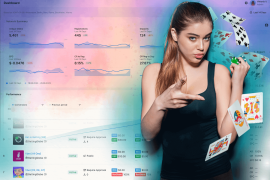Cross-device attribution is the process of connecting a customer’s interactions across multiple devices to properly allocate conversion credit to the touchpoints that influenced their purchase decision.
Tracking customer journeys across devices is crucial to understanding how your marketing efforts truly impact sales and revenue.
By implementing cross-device attribution, you gain visibility into the customer’s path to conversion and can optimize your marketing spend and strategies to drive the greatest return on investment. With consumers using an average of 3.4 connected devices, cross-device attribution is essential for gaining a complete view of the customer journey and maximizing the impact of your affiliate marketing campaigns.
In this article, we will explore how cross-device attribution works, the benefits for affiliate marketers, and tips for getting started.
What Is Cross-Device Attribution?
Cross-device attribution refers to tracking the customer journey across multiple devices to properly attribute conversions and give affiliate partners accurate credit for their influence.
People’s buying journeys have become increasingly complex as they use more connected devices. Customers will research products on their phone, compare options on a tablet, and purchase on their laptop. Suppose you only track affiliate referrals and conversions on a single device.
In that case, you miss a huge part of the picture and end up underpaying or not paying your affiliate partners for their impact.
To implement cross-device attribution, you need a way to identify users across devices and tie those identities to your tracking data. The most common methods for cross-device identification are:
- Login data: If a user logs into your site or app on multiple devices, you can tie their activity together. However, many users don’t log in, so this only provides part of the solution.
- Device fingerprinting: Analyzing details about a device like screen size, browser, fonts installed, etc. to create a unique fingerprint and look for that fingerprint on other devices. This can be an imperfect solution on its own.
- Probabilistic matching: Algorithmically determining the likelihood that two devices actually belong to the same user based on a variety of signals. When combined with other methods, probabilistic matching can be very effective for cross-device attribution.
By implementing an effective cross-device attribution solution, you gain a much clearer view of the customer journey and can properly reward your affiliate partners for the influence they have across devices. In today’s multi-device world, cross-device attribution is key to taking your affiliate marketing efforts to the next level.
Why Is Cross-Device Attribution Important for Affiliate Marketers?
As an affiliate marketer, you rely on accurate attribution to track customer journeys and optimize your campaigns. Cross-device attribution is essential for understanding how customers interact with your offers across multiple devices.
There are a few reasons why cross-device attribution is important for affiliate marketers:
- It provides a holistic view of the customer journey. Customers often use multiple devices to research and make a purchase. Cross-device attribution helps you understand the entire path to conversion across devices to optimize the experience at each touchpoint.
- It improves campaign performance. When you understand how customers are interacting with your campaigns across devices, you can make better optimization decisions to drive higher conversion rates, revenue, and ROI. You’ll know which devices and campaigns are most influential so you can double down on what’s working.
- It enhances targeting and personalization. Cross-device data provides insights into customers’ digital behaviors, interests, and preferences across devices. You can use this data to create highly targeted campaigns and personalized experiences tailored to customers’ needs.
As you can see, cross-device attribution is a game-changer for affiliate marketers.
By gaining a multi-device view of the customer journey and using those insights to optimize campaigns, you’ll be able to improve performance and significantly open up new opportunities for growth. Implementing a cross-device attribution solution is well worth the investment for any affiliate marketing program.
Methods of Cross-Device Attribution
To properly attribute conversions across devices, you must implement a cross-device attribution method. There are a few options to choose from:
Deterministic Matching
This method matches devices based on personally identifiable information (PII) like email addresses, phone numbers, or login credentials.
When a user logs in or provides PII on multiple devices, you can confidently attribute their actions across devices. However, not all users log in or provide PII, limiting the scale of this method.
Probabilistic Matching
This method uses algorithms and machine learning to detect statistical patterns in user behavior and match devices accordingly. Things like IP addresses, location data, browsing history, and more are analyzed to determine the likelihood of two devices belonging to the same user.
The accuracy of this method depends on the amount and quality of data available for analysis. More data typically means higher match rates and confidence levels.
Algorithmic Modeling
Some platforms build custom algorithms based on large datasets of cross-device user behavior. These proprietary algorithms, like Facebook’s Advanced Matching solution, can achieve high match rates by detecting complex patterns impossible with basic probabilistic modeling. However, transparency into how matches are made is limited, and accuracy depends on the dataset and algorithm.
In summary, a few common methods for cross-device attribution vary in scale, accuracy, and transparency.
For most advertisers, combining multiple methods will provide the best overall solution. By implementing cross-device attribution, you gain a more complete view of the customer journey and how each touchpoint influences conversions. You can then optimize spend and creatives accordingly to improve campaign performance across devices.
How to Implement Cross-Device Attribution for Your Affiliate Campaigns
To implement cross-device attribution for your affiliate marketing campaigns, there are a few key steps to take:
Choose an Attribution Model
The first step is selecting an attribution model to determine how conversion credit is assigned to the various touchpoints in the customer journey. The most common models for cross-device attribution are:
- Last Interaction: 100% of the credit is assigned to the last device used before the conversion.
- First Interaction: 100% of the credit is assigned to the first device used.
- Linear: Credit is distributed evenly across all devices.
- Time Decay: More credit is assigned to interactions closer to the conversion.
- Algorithmic: An algorithm analyzes the customer journey and determines how much credit to assign to each device.
Implement Tracking for Cross-Device Journeys
You’ll need to implement a tracking solution to track customers across devices by linking common identifiers like IP addresses, login info, and other attributes. Many affiliate networks and tracking platforms offer cross-device tracking and attribution features.
Analyze Performance and Optimize
Review reports to see how your campaigns are performing across devices. Look for trends in the customer journey and see which channels and partnerships are most effective at driving cross-device conversions. Make optimizations to improve performance, such as adjusting bids, creatives, and placements to target multi-device users better.
Consider a Multi-Channel Approach
To maximize the potential of cross-device attribution, consider promoting your offers across multiple digital channels, including:

- Paid search
- Social media
- Display ads
- Email marketing
- Referral programs
A multi-channel approach will allow you to gain more high-quality touchpoints in the customer journey and drive higher cross-device conversion rates.
With the right tracking and attribution in place, you can properly value each channel’s influence and optimize your marketing budget allocation.
How to Maximize Results from Cross-Device Attribution?
To further maximize affiliate marketing results with cross-device attribution, some additional tactics to explore include:
- Testing different creative assets across devices to see what drives the highest engagement and conversions. Simple changes in images, colors or text can make a difference in performance between smartphones, tablets and laptops.
- Leveraging mobile apps as part of the cross-device strategy. Many consumers now begin their product research or shopping on mobile apps. Integrating app tracking can provide valuable insights.
- Partner with influencers and bloggers with large followings across multiple social platforms and devices. Their cross-device reach
- Experimenting with different types of content – from short-form videos to long-form blogs posts – tailored to specific devices. Consider how content is consumed on smartphones versus laptops.
- Continually optimizing the user experience for a seamless cross-device transition. Make it easy for customers to continue purchasing from any device at any point.
With an emphasis on testing, learning and optimizing various tactics, a data-driven approach using cross-device attribution can help you identify the strategies with the highest potential to increase affiliate marketing results.
The key is gaining insights into how customers make decisions and convert across their different devices and channels.
Case Studies: How Top Affiliates Are Using Cross-Device Attribution
To maximize your affiliate marketing efforts, implementing cross-device attribution is key. This allows you to track users across multiple devices and properly attribute conversions and commissions to the appropriate affiliates.
Case Study: Rakuten Marketing
Rakuten Marketing, a leader in affiliate marketing, utilizes cross-device attribution to provide affiliates with a holistic view of the customer journey. By connecting the dots between devices, Rakuten helps affiliates see the full picture of how customers interact with their campaigns and content across devices. This allows affiliates to optimize their campaigns to drive the highest converting traffic.
Case Study: CJ Affiliate
CJ Affiliate, a large affiliate network, provides cross-device tracking and attribution to affiliates. This allows affiliates to understand how customers are interacting with their offers across devices, which helps affiliates make data-driven optimization decisions. With cross-device attribution, affiliates can see the true value of their marketing efforts.
Benefits for Affiliates
Implementing cross-device attribution provides several benefits for affiliates:
- Gain insight into the entire customer journey across devices. See how customers discover your offers and content on one device, then convert on another.
- Properly attribute conversions and give credit to the right affiliates. Avoid inaccurately attributing a conversion to the last affiliate a customer clicked before converting.
- Optimize your campaigns and content for the best performance. Focus your efforts on the affiliates, offers, and content that drive conversions.
- Increase your commissions and ROI. By optimizing based on cross-device insights, you can drive more high-quality traffic and conversions.
Cross-device attribution is a must for affiliates looking to enhance their marketing efforts and gain a competitive advantage. Connecting the dots between devices will give you valuable insights to boost your campaigns and increase your bottom line.
Why Choose Scaleo as Your Affiliate Marketing Software?
Saleo is a leading affiliate marketing software that supports cross-device attribution, but that is not all. It also offers…
Robust Features
Scaleo offers robust features designed specifically for affiliate marketers and media buyers. Some of the key features include:
- Cross-device tracking to attribute conversions across devices. This lets you see the entire customer journey and properly attribute sales to the affiliates that influenced the purchase.
- Real-time reporting to monitor your campaigns and make optimizations on the fly. You can see clicks, impressions, conversions, and revenue in real-time to see what’s working and make changes immediately.
- Fraud detection to identify invalid clicks, impressions and conversions. Scaleo uses advanced machine learning to detect fraudulent activity and ensure you only pay for valid, high-quality traffic and sales.
- Automated billing generation to pay your affiliates on time, every time. Scaleo’s payout automation removes the hassle of manually processing affiliate payments each month.
Integrations & APIs
Scaleo integrates with many of the top affiliate networks, traffic sources, payment gateways and more. Some of the available integrations include:
- Major affiliate networks like Awin, Rakuten, CJ Affiliate, etc.
- Popular traffic sources such as Google Ads, Facebook Ads, Outbrain, etc.
- Payment gateways like PayPal, Wire Transfer, Check, etc. to pay your affiliates
Scaleo also offers a robust API to build custom integrations with any platform. The API allows you to pull reports, update settings, add offers and more. The Scaleo API opens up many opportunities for developers to build tools and applications on top of the Scaleo platform.
Dedicated Support
With Scaleo, you get dedicated one-on-one support from our affiliate marketing experts. Our support team can help you:
- Set up your Scaleo account and connect data sources
- Optimize your affiliate recruitment and increase program engagement
- Detect and prevent fraud to maximize your return on investment
- Answer any questions you have about the Scaleo platform and affiliate marketing best practices

Looking Ahead
The future of cross-device attribution in affiliate marketing is likely to be shaped by advances in technology and changes in data privacy regulations.
Techniques are expected to improve in accuracy and sophistication, leaning more on machine learning and artificial intelligence.
However, the industry will also need to adapt to increasing user demand for privacy and changes in how user data can be collected and used.
Conclusion
As you have seen, implementing cross-device attribution in your affiliate marketing campaigns can significantly improve your results and take your efforts to the next level. By gaining a holistic view of the customer journey across devices and touchpoints, you gain valuable insights into the true impact of your marketing spend. You can optimize your campaigns and double down on the channels and partnerships driving the most value.
While cross-device attribution does require investment in tools and resources, the rewards of enhanced data, streamlined processes, and boosted ROI make it well worth the effort. Cross-device attribution is the logical next step for any affiliate marketer looking to strengthen their approach, drive more sales, and build a sustainable long-term business. The future of affiliate marketing is cross-device, and the time to embrace it is now.
With the right approach and partnerships, you can leverage cross-device attribution to gain a competitive advantage, better serve your customers, and take your affiliate marketing efforts to the next level.
What is cross-device attribution in affiliate marketing?
Cross-device attribution in affiliate marketing refers to the process of tracking and assigning credit to various marketing touchpoints across multiple devices used by a single user. This allows marketers to gain a comprehensive understanding of the customer’s journey, from initial touchpoint to the final purchase, even if they switch devices in between.
Why is cross-device attribution important in affiliate marketing?
Cross-device attribution is important in affiliate marketing because today’s customers often use multiple devices before making a purchase. Without this, the customer journey might appear fragmented and marketers might not properly recognize the value of certain marketing efforts. With cross-device attribution, a marketer can fully understand how different affiliate touchpoints contribute to a sale and optimize their marketing strategy accordingly.
How does cross-device attribution work?
Cross-device attribution works through either deterministic or probabilistic methods. Deterministic attribution uses logged-in user data across devices, like when a user logs into an app on their smartphone and on their laptop. Probabilistic attribution, on the other hand, uses advanced algorithms and machine learning to match devices to a single user based on data points like IP addresses, device type, operating system, and browsing behaviors.
Is cross-device attribution always accurate?
No. While cross-device attribution aims to provide the most accurate overview of the customer journey possible, it isn’t always 100% accurate. Deterministic tracking is generally more accurate but is limited by the need for users to be logged in across devices. Probabilistic tracking, while it can cover more ground, is based on statistical likelihoods and therefore may not always correctly match devices to users.
How does data privacy affect cross-device attribution in affiliate marketing?
Data privacy regulations such as GDPR and CCPA, as well as industry changes like the phase-out of third-party cookies, pose significant challenges to cross-device attribution. Marketers must ensure they’re respecting user privacy and obtaining necessary consents when tracking users across devices.
Last Updated on January 17, 2024





